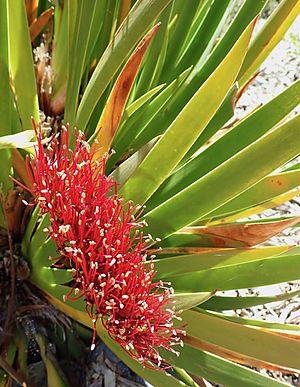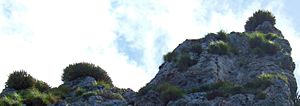Xeronema callistemon facts for kids
Quick facts for kids Xeronema callistemon |
|
|---|---|
 |
|
| Poor Knights lily, Otari-Wilton's Bush, Wellington, New Zealand | |
| Scientific classification | |
| Genus: |
Xeronema
|
| Species: |
callistemon
|
The Poor Knights lily (Xeronema callistemon) is a beautiful flowering plant that grows only on a few special islands off the coast of New Zealand. It was first discovered in 1924. This unique plant is sometimes called the "Poor Knights lily" because it grows on the Poor Knights Islands.
Contents
What's in a Name?
The common name, Poor Knights lily, comes from the Poor Knights Islands where this plant was found. These islands got their name because they looked like a popular bread dish called "Poor Knights Pudding." This dish was well-known when Europeans first explored the area.
The plant's scientific name, Xeronema callistemon, comes from ancient Greek words. "Callistemon" means "with a beautiful stamen." This refers to the plant's bright red stamens, which are the parts of the flower that hold pollen.
How the Poor Knights Lily Looks
The Poor Knights lily has green stalks that first grow straight up. These stalks are covered by overlapping leaves. As the flower starts to appear, the stalk turns sideways.
Then, a bright red flower part grows, looking like a giant bottle brush or toothbrush. This part has many prominent red stamens. The tips of these stamens are orange and hold pollen.
Each individual flower part is about 10 to 15 millimeters long. The stamens can be up to 4 centimeters tall. The whole "brush" part is usually between 18 and 25 centimeters long, but it can grow up to 45 centimeters! The entire plant can be about 1 meter tall and spread out 1 to 4 meters wide.
Where the Poor Knights Lily Lives
The Xeronema callistemon usually grows on rhyolite sea cliffs and rocky areas. Sometimes, it can also be found in forests. This plant needs a lot of water to grow well.
Birds and butterflies help pollinate this plant. This means they help move pollen from one flower to another, which helps the plant make seeds. If a seed falls onto a nearby tree, like a Metrosideros excelsa, the lily might even grow on that tree as an epiphyte. An epiphyte is a plant that grows on another plant but does not harm it.
This plant does not seem to have many natural enemies. It is considered special because it only grows naturally on two islands. The New Zealand Government protects these islands as nature reserves. This means access to the islands is limited to help keep the plants safe. Even though it's protected, the Poor Knights lily is becoming popular for people to grow in their own gardens.
A plant related to the Poor Knights lily, called Xeronema moorei, is found far away on the islands of New Caledonia.
Life Cycle and Growth
New Poor Knights lily plants grow from fresh seeds that fall to the ground. These seeds sprout easily. However, it can take a long time for the plants to grow big enough to flower. It might take 10 to 15 years before they produce their beautiful blooms!
The plants flower between September and December in New Zealand. This is during the spring season there. The most flowers usually appear in October.


